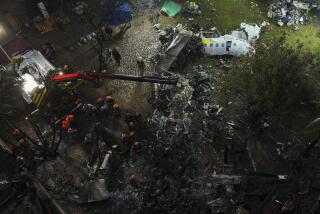14 Die in Texas as Commuter Plane Crashes : Disaster: Witnesses say the Brazilian-built twin-engine aircraft exploded before plunging into a cornfield 60 miles southwest of Houston.
- Share via
HOUSTON — A twin-engine Continental Express commuter plane en route from Laredo to Houston crashed and burned in a cornfield about 60 miles southwest of here Wednesday morning, killing all 14 aboard.
Witnesses said they heard an explosion in the sky and the plane appeared to be on fire as it plunged to the ground near the rural town of Eagle Lake, but federal investigators said it was far too early to determine what caused the crash.
Charlie Labay said he was working in his rice field across the Colorado River from the crash site when he heard the explosion.
“It shook the ground, it blowed so hard,” the 76-year-old farmer said. “As soon as it blowed, you saw a big ball of fire. . . . My son seen the wing fall off. (The plane) come down quickly, it wasn’t trying to land or nothing.”
Emergency crews summoned by the rice farmer’s telephone calls said they found the bodies of the pilot, co-pilot, flight attendant and 11 passengers scattered amid the charred wreckage. None of the victims were immediately identified.
Investigators said the plane was a Brazilian-built Embraer E-120, the same type of aircraft that crashed last April near Brunswick, Ga., killing former Sen. John Tower of Texas, his daughter, Marian, astronaut Manley (Sonny) Carter Jr. and 20 others.
While the cause of the crash in Georgia has not been established officially, investigators said the plane suffered a propeller malfunction seconds before the accident.
Pilot error was blamed in the January, 1988, crash of another Continental Express commuter plane--a Fairchild Metro III turboprop--in Durango, Colo., that killed nine.
Steve Kolski, president of Continental Express, a wholly owned subsidiary of Houston-based Continental Airlines, said Wednesday that Flight 2574 took off from Laredo at about 9 a.m. and climbed without incident to a cruising altitude of 23,000 feet.
Shortly before 10 a.m., he said, air traffic controllers in Houston cleared the plane to descend to 9,000 feet in preparation for its final approach to Houston Intercontinental Airport.
Kolski said the cockpit crew did not mention any trouble.
Moments later, while descending though 11,800 feet, the plane suddenly vanished from the controllers’ radar screens, Kolski said. At the same time, he said, the controllers lost radio contact with the aircraft.
Shirley Labay, 36, said her 35-year-old husband, Clifton, her brother-in-law, Cary, 23, and their father, Charlie, were working on one of Charlie Labay’s tractors when they heard a “big boom” up in the sky.
“Clifton told me he thought a bolt of lightning had struck, but when he looked up, he saw red flames in the sky and he realized it was an airplane on fire,” she said. “He said the left wing had come off. . . . They didn’t see it hit the ground, because it was behind the trees, on the other side of the river.” Shirley Labay said the three men jumped into a pickup truck and drove to her father-in-law’s farmhouse, where they telephoned the two nearest fire departments before heading for the crash site themselves.
Because the nearest bridge is several miles downstream, the three men had to drive almost 20 miles before reaching the cornfield where the plane hit.
“By the time they got there, it was all burned up,” she said.
The Embraer E-120 is a 30-passenger plane that can cruise up to 1,000 miles at speeds of more than 300 m.p.h. First introduced to the United States in 1985, it has become popular with commuter lines around the world because of its speed and range.
NTSB investigators were en route to Eagle Lake Wednesday afternoon to begin their investigation of the latest crash.
Malnic reported from Los Angeles and Hart from Houston.
Embraer EMB-120 Brasilia
Twin-turboprop passenger and cargo transport, built in Brazil Wingspan: 64 ft. 11 in. Overall length: 65 ft. 7 in. Crew: two Passenger capacity: 30 Source: Modern Commercial Aircraft
More to Read
Sign up for Essential California
The most important California stories and recommendations in your inbox every morning.
You may occasionally receive promotional content from the Los Angeles Times.












